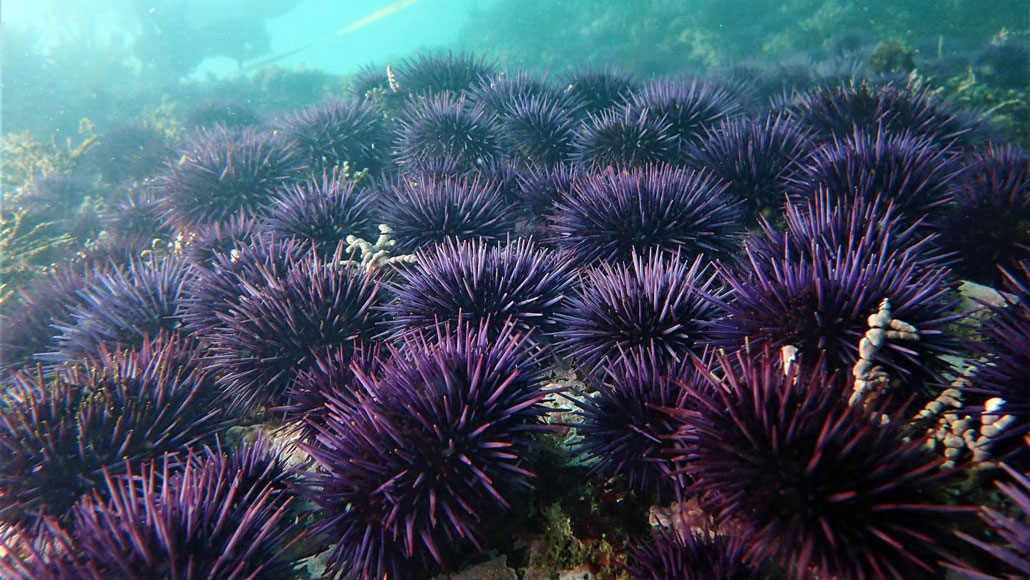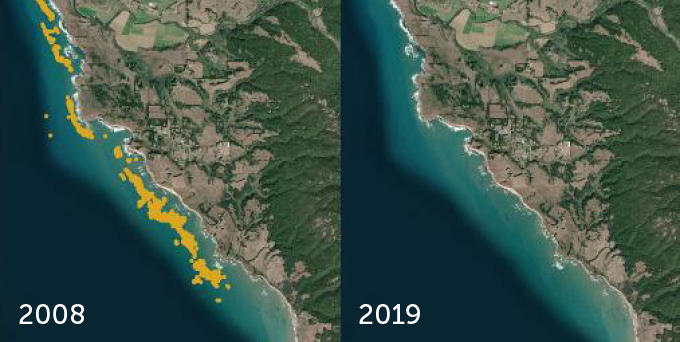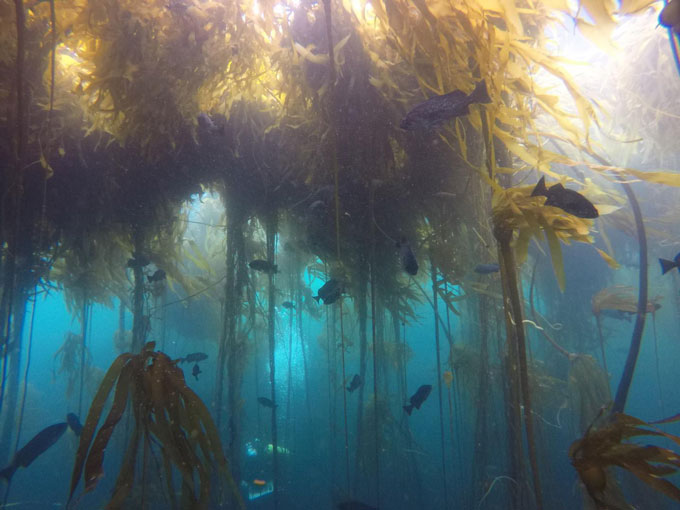Urchin takeover underlies California’s vanishing kelp forests
While its northern kelp forests are all but gone, things look more hopeful farther south

Proliferating sea urchins, such has these off northern California, have destroyed kelp forest all along the state’s coast.
Katie Sowul/CDFW
Joshua Smith started diving in Monterey Bay in 2012. Back then, waters along this part of Central California looked very different. He likens its underwater environment at the time to a redwood forest. Towering kelp rose like “tall cathedrals,” recalls this ecologist at the University of California, Santa Cruz. Their tops were lush — so thick Smith’s boat found it hard to maneuver over them.
But no more. Those massive underwater forests have been reduced to thin thickets popping out of an otherwise largely barren seafloor. That’s what Smith and his colleagues now report in the March 16 Proceedings of the National Academy of Sciences. About the only things left in these empty zones are sea urchins. And they have had so little to eat and become so puny that hungry sea otters have no interest in dining on them. Normally, otters would eat enough of them to keep populations of kelp-eating urchins from growing out of control. That would have helped keep kelp forests healthy.
An even worse scene has been playing out farther up the coast, a second study finds. A thick kelp forest once stretched throughout some 350 kilometers (almost 220 miles) along northern California. More than 95 percent of that kelp is now gone, satellite imagery shows. It has disappeared just since 2014.
What had recently been some 210 hectares (almost 520 acres) of kelp is now a few patches of forest covering a total of only about 10 hectares. Meredith McPherson is a marine biologist at UC Santa Cruz. She and her colleagues described this enormous loss March 5 in Communications Biology. Like the barrens farther south, the remaining kelp has become a buffet for hungry purple sea urchins.

These two studies reveal devastation to a once strong ecosystem. A deep dive into the impacts of their loss may also offer clues on how some of the lost forests may be induced to return.
Environmental double-whammy hammered kelp
California’s kelp forests had provided a rich habitat for sea life. But over the past decade, they’ve been hit by a double whammy of eco-disasters, notes Mark Carr. He’s an ecologist at UC Santa Cruz and a coauthor on the Communications Biology paper. He also has been a mentor to both McPherson and Smith.
Sea-star wasting syndrome dealt the first blow. It wiped out local populations of sunflower sea stars. Those starfish typically feed on urchins. Without sea stars, purple sea urchins (Strongylocentrotus purpuratus) overwhelmed the region.
The second wallop was a marine heat wave. It was so big and persistent that scientists nicknamed it “The Blob”. While kelp forests have survived ocean warming before, this event was so extreme it spiked temperatures in many parts of the Pacific to between 2 and 3 degrees Celsius (3.6 and 5.4 degrees Fahrenheit) above normal.
Kelp thrives in cold, nutrient-rich water. As the warming water slowed its growth, less yummy kelp drifted into the crevices of the reefs where hungry sea urchins typically lurk. With the sunflower sea stars gone and kelp meals no longer coming to them, urchins emerged from the reef. They turned to the remaining kelp and began devouring it.
What happened to northern California’s kelp forests may doom their chance of recovery. First, the dominant species there is bull kelp. It dies back each winter. But the warming water and loss of sea stars there are making it more difficult to bounce back each spring. In comparison, one of the main kelp species in Monterey Bay is giant kelp. Because it lives for many years, it is a bit more resilient.

The more northerly kelp forests also lack sea otters, an urchin predator that is common farther south. Those sea otters are what’s providing a glimmer of hope in Monterey Bay. Smith and his colleagues wondered how otters there were responding to the bonanza of sea urchins. The otters were eating three times as many sea urchins as they had before 2014.
They have also become pickier.
Those otters have avoided the more populous urchin barrens. Instead, they dine only on urchins in the remaining patches of kelp. The barrens, it turns out, offer only a poor diet of scraps. Urchins find so little food that their bodies essentially become hollow. “Zombies,” Smith calls them.
Nutrient-rich urchins in the healthy kelp offer sea otters a far better snack. And by zeroing in on those urchins, the otters have kept forest dwelling urchins from scarfing up the remaining kelp.
Relocating otters is a solution, but not easy
Sea otters can be transplanted in new locations. But doing so can prove tricky. That’s what an experiment off the Pacific Coast of Canada shows. Bringing in otters helped the local kelp forests rebound. But those otters ended up competing with people, especially Indigenous communities, for shellfish.
There’s a lot of work to figuring how science may bring back sunflower sea stars. It has become a critically endangered species. Adding to the problem: The cause of its wasting syndrome is still unknown.
Even so, understanding these links between species in an ecosystem can provide clues to restoring lost kelp forests, says ecologist Marissa Baskett. She works at the University of California, Davis. And that, she adds, may become ever more important in a warming climate where “future marine heat waves” can be expected.







